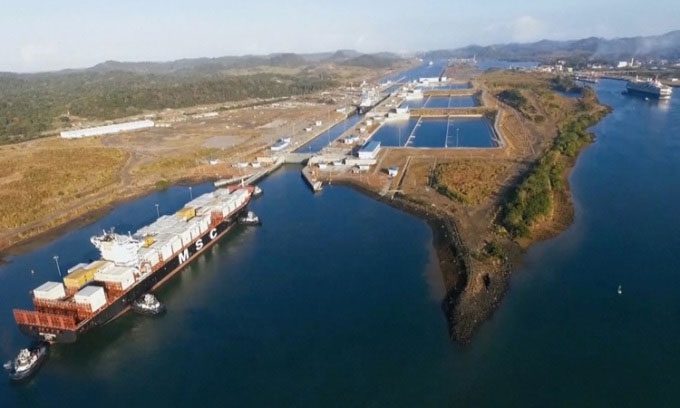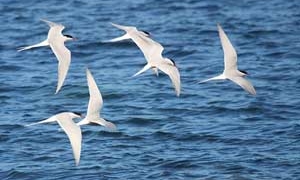Measures such as constructing water reservoirs and artificial rain are time-consuming to implement while the Panama Canal is severely affected by drought.
A few hundred meters from massive vessels transporting goods around the globe, withered tree stumps emerge from the water’s surface. These are remnants of the forest that was submerged over a century ago to create the canal. At the peak of the dry season, seeing them is not unusual. However, now, after the rainy season, they should be completely submerged. This is visible evidence of the impact of drought on the waterway handling $270 billion worth of cargo annually, according to Bloomberg.

The Panama Canal is experiencing the worst drought in 70 years. (Photo: CGTN).
The Panama Canal Authority (PCA) is considering potential solutions including building water reservoirs to supply the canal and creating artificial rain to increase precipitation, but both options require many years to implement, if feasible. With water levels 1.8 meters lower than normal, the canal authority has had to limit the number of ships passing through. The restrictions imposed at the end of last year were the strictest since 1989. Some shipping companies are paying millions of dollars to avoid waiting in line, while many others are taking longer and more costly routes around Africa or South America.
Restrictions were eased thanks to higher-than-expected rainfall in November 2023, but at a maximum of 24 ships per day, this number is still much lower than the pre-drought capacity of 38 ships. As the dry season approaches, the situation is expected to worsen. The condition of the canal reflects the impact of climate change on global trade flows. Droughts have created vulnerabilities on the Mississippi River in the U.S. and the Rhine River in Europe. In the UK, rising sea levels increase the risk of flooding along the Thames River. Melting ice is creating new waterways in the Arctic.
Under normal circumstances, the Panama Canal handles about 3% of global maritime trade volume and 46% of container shipments from Northeast Asia to the U.S. East Coast. The canal is Panama’s largest source of income, generating $4.3 billion in 2022. To allow 24 ships to pass in a day during the dry season, the canal will release water from Alajuela Lake, a secondary reservoir. If rains begin in May, the canal could increase its traffic volume, according to Erick Córdoba, PCA’s water manager. But this is only a short-term solution. In the long term, the key solution to chronic water shortages is to build a dam on the Indio River, followed by drilling a tunnel through the mountains to channel fresh water 8 kilometers into Gatun Lake, the canal’s main reservoir.
Along with other conservation measures, the project is estimated to cost around $2 billion, Córdoba estimates. He stated that at least six years are needed to construct the dam. The U.S. Army Corps of Engineers is conducting a feasibility study. The Indio River reservoir will increase the number of ships, sufficient to maintain the canal while providing clean water for Panama City. The country will need to build dams on more rivers to ensure adequate water supply by the end of the century. However, promoting the proposal is not straightforward, as it requires approval from Congress and the agreement of thousands of farmers and ranchers who oppose the plan due to the flooding of their lands.
Another potential solution is more experimental. In November 2023, a small aircraft operated by Weather Modification Inc. from North Dakota arrived in Panama to test artificial rainmaking, a process that involves spraying large salt particles into clouds to encourage condensation and create rain. However, artificial rainmaking has primarily been successfully applied in dry weather, not in tropical regions like Panama.
Some shipping companies have expressed frustration over the PCA’s slow response to low water levels. “There are no major infrastructure projects underway in Panama to increase the supply of clean water,” shared Jeremy Nixon, CEO of the Japanese container shipping company Ocean Network Express Holdings Ltd. (ONE).
Climate change combined with infrastructure expansion is causing difficulties at the canal. The PCA has completed a series of new locks to increase traffic and keep pace with the ever-growing size of cargo ships. What they have not done is build a new reservoir to pump enough fresh water, and then the drought occurred. As of last November, 2023 has been the driest year on record at Barro Colorado Island in Gatun Lake, according to Steve Paton, director of the Smithsonian Tropical Research Institute’s natural monitoring program.
Global warming exacerbates the effects of the El Niño weather phenomenon, bringing dry conditions to Panama, expected to last at least until March in the Northern Hemisphere. Gatun Lake is drying up faster during the dry season, and rising temperatures accelerate evaporation. In 2023, trade winds were not unusually weak, contributing to record-high water temperatures along Panama’s Pacific and Atlantic coasts. Weak winds also mean that rain clouds cannot drift toward Gatun. For many days, rain has poured down in Panama City while the lake receives very little precipitation.
The crisis obstructs the waterway, which has been available for over a century. When it began operations in 1914, the canal provided an alternative to the Suez Canal, Cape of Good Hope, and the Strait of Magellan for transporting goods between the Northern and Southern Hemispheres. Now, shipping companies are reverting to all three of those options to avoid congestion in Panama.
While Suez is a sea-level canal, Panama is a freshwater canal reliant on artificial lakes, making it vulnerable to drought. Jorge Luis Quijano, an advisor and former PCA director, stated it could take a year for the lake to return to normal flow. Quijano noted that he saw the problem a decade ago while overseeing the construction of additional locks to accommodate larger ships passing through the canal. Locks are engineering marvels but also consume a significant amount of water.
Seawater mixes with freshwater when locks operate. To prevent the country’s largest moving water source, Gatun Lake, from becoming saline, the canal releases enough water to fill 76 Olympic-sized swimming pools with each ship. The vast basin returns some water back to the lake, but because this process increases salinity, it can only be used sparingly. Before his term ended, Quijano urged the government to begin constructing additional reservoirs but was unsuccessful.




















































